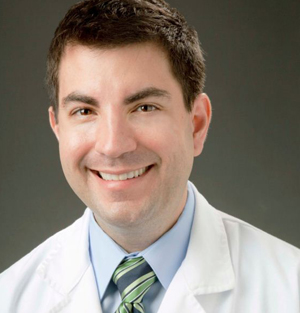Inspired by Progress in Usher Syndrome Research
Eye On the Cure Research News
Mark Pennesi, M.D., Ph.D., a Foundation-funded clinical researcher at the Casey Eye Institute, discusses the first human study of gene therapy for Usher syndrome type 1B.

Dr. Mark Pennesi. Mark Pennesi, M.D., Ph.D., is a Foundation-funded clinical researcher at the Casey Eye Institute, Oregon Health & Science University. His research focuses on developing novel treatments for inherited retinal diseases. He is currently exploring the potential of a new class of drugs to up-regulate protective growth factors in the retina.
When I first heard about Usher syndrome, the leading cause of combined blindness and deafness, I was 19, fresh out of high school and very privileged for the opportunity to work as a summer student at the Retina Foundation of the Southwest with David Birch, Ph.D. I was quite moved by the patients — their eagerness for any kind of treatment and the fear that they might pass their disease on to other family members. That was almost 20 years ago. Back then, we knew very little about the condition, especially its genetic diversity, and there were no foreseeable therapies.
Things have changed. We are closer than ever to having treatment options for patients with this challenging disease. I can now envision a day when we'll have treatment strategies for all the different forms of Usher syndrome, and I'd like to highlight some of the exciting work that is being supported by the Foundation Fighting Blindness to get us there.
But first, let me give you a quick primer on Usher syndrome. It's a genetic disease that results when there are mutations (defects) in genes that are important for the function of both photoreceptors in the retina and hair cells in the cochlea, or inner ear. So far, we've found 11 genes that, when mutated, can cause different subtypes of Usher syndrome. These mutations usually lead to either a deficiency or defective version of a protein that's critical for the health and function of the retina and cochlea.
One strategy for treatment is to use gene therapy to introduce new, normal copies of the gene into the remaining cells of the retina. Fortunately, nature has given us the perfect tool for doing this. We can modify viruses, also known as vectors, by taking out the elements that can make you sick and replacing them with the therapeutic gene.
Gene therapy for Usher syndrome is challenging for several reasons — let me highlight two. First, several genes involved are relatively large, and won't fit in the vectors that have been used in gene therapy trials for other retinal degenerations. Second, by the time Usher syndrome is diagnosed, many patients have already lost a significant number of photoreceptor cells. Gene therapy won't bring back those cells, but it does have the potential to slow down or halt degeneration — saving a person's precious, remaining photoreceptors — until other therapies, such as stem cells, become available to replace lost photoreceptors.
At the Casey Eye Institute, we've started the first human study of gene therapy for Usher syndrome type 1B, which is caused by mutations in the MYO7A gene. The primary investigator of this trial is my colleague and mentor, Richard Weleber, M.D., who has been studying retinal diseases for almost 40 years. Additionally, Jose Sahel, M.D., and Isabelle Audo, M.D., Ph.D., at Hopital Quinze Vingt in Paris, are participating in this trial. Known as UshStat®, the treatment uses a special vector that can deliver large genes such as MYO7A.
We have treated four participants so far, and hope to enroll the remaining 14 participants in the next year. It's still too early to know if the gene therapy is working, but the fact that we have moved the treatment into a human study is very exciting.
Other groups are working on new methods to deliver the large genes causing Usher syndrome, such as USH2A, the most common gene linked to Usher syndrome type 2. Muna Naash, Ph.D., at the University of Oklahoma, is using nanoparticles — tiny manmade particles that can readily penetrate cells — to deliver this large gene into photoreceptors of animals.
Gene therapy is just one of the exciting innovations percolating up from the lab into human studies. Jennifer Lentz, Ph.D., is developing a treatment for Usher syndrome type 1C using anti-sense oligonucleotides (ASOs), which are essentially pieces of DNA used to correct mutations. Premature stop codons are common mutations in type 1C and result in a truncated, ineffectual protein. ASO drugs help retinal cells "read through" these mutations so that the entire protein can be made. Premature stop codons often lead to other forms of Usher syndrome and other retinal diseases, so ASOs may benefit many people.
hese are just a few of the advancements in Usher syndrome research funded by the Foundation, and we're making more progress every year. The future has never looked brighter, and it's quite a thrill for me to be a part of this cutting-edge research.




